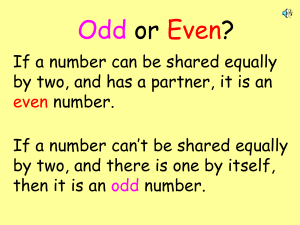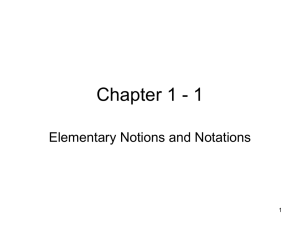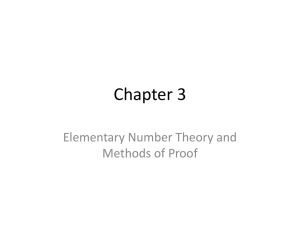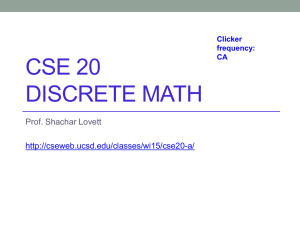Document
advertisement
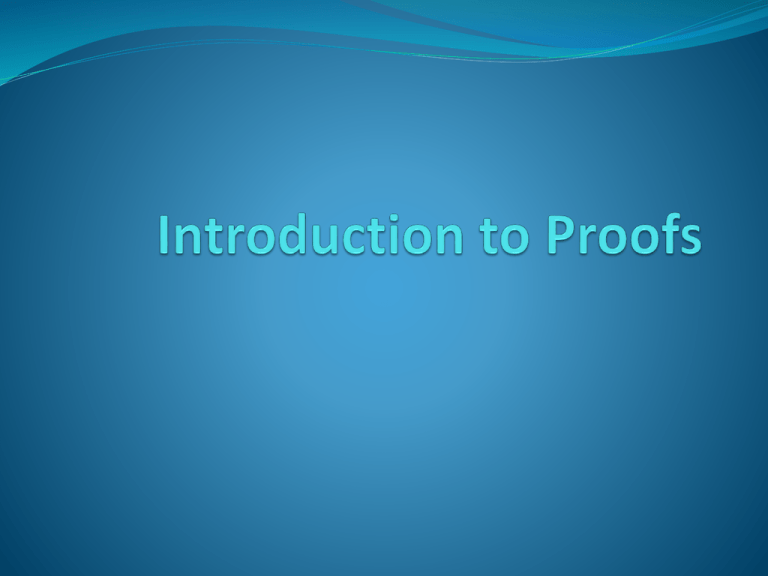
Introduction to Proofs A proof is a valid argument that establishes the truth of a statement. Previous section discussed formal proofs Informal proofs are common in math, CS, and other disciplines More than one rule of inference are often used in a step. Steps may be skipped. The rules of inference used are not explicitly stated. Easier to understand and to explain to people. They are generally shorter but it is also easier to introduce errors. Definitions A theorem is a statement that can be shown to be true using: definitions other theorems axioms (statements which are given as true) rules of inference A lemma is a ‘helping theorem’ or a result that is needed to prove a theorem. A corollary is a result that follows directly from a theorem. A conjecture is a statement proposed to be true. If a proof of a conjecture is found, it becomes a theorem. It may turn out to be false. Proving Theorems: Conditionals Many theorems have the form: To prove them, we consider an arbitrary element c of the domain and show that: The original statement follows by universal generalization So, we need methods for proving implications of the form: Working with Integers and Reals Important definitions: An integer n is even if there exists an integer k such that n = 2k An integer n is odd if there exists an integer k, such that n = 2k + 1 Note that every integer is either even or odd and no integer is both A real number r is rational if there exist integers p and q such that r = p/q and q≠0. We can also assume that p and q have no common factors Proving Conditional Statements: p → q Direct Proof: Assume that p is true. Use rules of inference, axioms, and logical equivalences to show that q is also true. Example: Give a direct proof of the theorem “If n is an odd integer, then n2 is odd.” Solution: Assume that n is odd. Then n = 2k + 1 for an integer k. Squaring both sides of the equation, we get: n2 = (2k + 1)2 = 4k2 + 4k +1 = 2(2k2 + 2k) + 1 2k2 + 2k is an integer, let’s say r So n2 = 2r + 1 and hence n2 is odd. This proves that if n is an odd integer, then n2 is an odd integer. Proving Conditional Statements: p → q Example: Give a direct proof of the theorem “If c ≥ 6 then c2+c > 2c” Solution: Assume that c ≥ 6. Simplify the conclusion: Subtract c from both sides of c2+c > 2c to get c2 > c. c is always positive so divide both sides by c to get c > 1. With this simplification, the theorem states “If c ≥ 6 then c > 1” This is always true and hence the original formulation is also true Proving Conditional Statements: p → q Proof by Contraposition: Assume ¬q and show ¬p is true also Recall that (¬q → ¬p ) ≡ (p → q) This is sometimes called an indirect proof method We use this method when the contraposition is easier to demonstrate than the proposition Consider this method when p is more complicated than q Examples: For any integer k, if 3k+1 is even then k is odd If n is an integer and n2 is odd then n is odd If n3+5 is odd then n is even Proving Conditional Statements: p → q Example: Prove that if n is an integer and 3n+2 is odd, then n is odd. Solution: p ≡ 3n+2 is odd q ≡ n is odd First state the contrapositive: ¬q → ¬p If n is even (not odd) then 3n+2 is even (not odd) Assume n is even (¬q). So, n = 2k for some integer k. Thus 3n+2 = 3(2k)+2 = 6k +2 = 2(3k+1) = 2j for j = 3k+1 Therefore 3n+2 is even (¬p). Since we have shown ¬q → ¬p , p → q must hold as well If 3n+2 is odd then n is odd Proving Conditional Statements: p → q Example: Prove that for an integer n, if n2 is odd, then n is odd. Solution: Use proof by contraposition: if n is even then n2 is even Assume n is even: n = 2k for some integer k Hence n2 = 4k2 = 2 (2k2) Since 2k2 is an integer, n2 is even We have shown that if n is even, then n2 is even. Therefore by contraposition, for an integer n, if n2 is odd, then n is odd. Proof by Contradiction Another indirect form of proof To prove p, assume ¬p Derive a contradiction q such that ¬p → q This proves that p is true Why is this reasoning valid: A contradiction (e.g., r ∧ ¬r) is always F, hence ¬p → F Since ¬p → F is true, the contrapositive T→p is also true Proof by Contradiction Example: prove by contradiction that √2 is irrational. Solution: Suppose √2 is rational. Then there exists integers a and b with √2=a/b, where b≠0 and a and b have no common factors Then and Therefore a2 must be even. If a2 is even then a must be even (shown separately as an exercise). Since a is even, a = 2c for some integer c, thus and Therefore b2 is even and thus b must be even as well. If a and b are both even they must be divisible by 2. This contradicts our assumption that a and b have no common factors. We have proved by contradiction that our initial assumption must be false and therefore √2 is irrational . Proof by Contradiction Can also be applied to prove conditional statements: p → q To prove p → q, assume ¬(p → q) ≡ (p ∧ ¬q) Derive a contradiction such that (p ∧ ¬q) → F This proves the original statement Example: Prove that if 3n+2 is odd, then n is odd (n is an integer). Solution: p ≡ 3n+2 is odd q ≡ n is odd Assume: p ∧ ¬q 3n+2 is odd ∧ n is even Since n is even, n = 2k for some integer k. Thus 3n+2 = 3(2k)+2 = 6k +2 = 2(3k+1) = 2j for j = 3k+1 Therefore 3n+2 is even This contradicts the assumption that 3n+2 is odd Since the assumption implies F, the original statement is T: If 3n+2 is odd then n is odd


